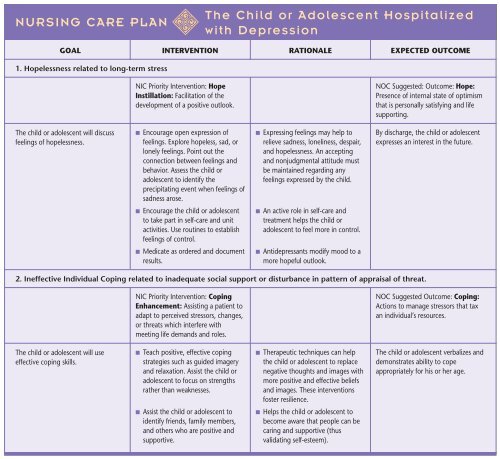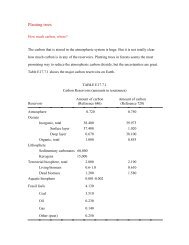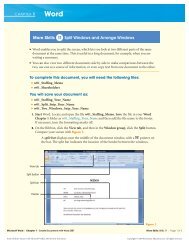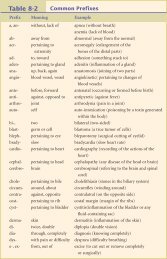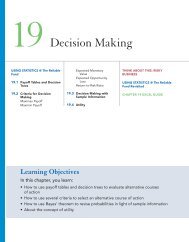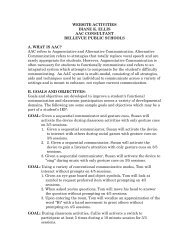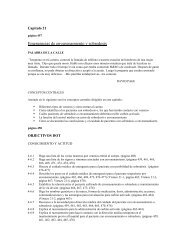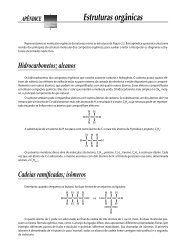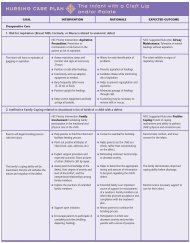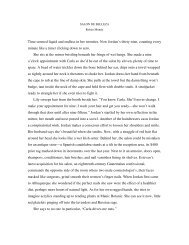928 NURSING CARE PLAN The Child or Adolescent Hospitalized ...
928 NURSING CARE PLAN The Child or Adolescent Hospitalized ...
928 NURSING CARE PLAN The Child or Adolescent Hospitalized ...
You also want an ePaper? Increase the reach of your titles
YUMPU automatically turns print PDFs into web optimized ePapers that Google loves.
<strong>NURSING</strong> <strong>CARE</strong> <strong>PLAN</strong><br />
NIC Pri<strong>or</strong>ity Intervention: Hope<br />
Instillation: Facilitation of the<br />
development of a positive outlook.<br />
■ Encourage open expression of<br />
feelings. Expl<strong>or</strong>e hopeless, sad, <strong>or</strong><br />
lonely feelings. Point out the<br />
connection between feelings and<br />
behavi<strong>or</strong>. Assess the child <strong>or</strong><br />
adolescent to identify the<br />
precipitating event when feelings of<br />
sadness arose.<br />
■ Encourage the child <strong>or</strong> adolescent<br />
to take part in self-care and unit<br />
activities. Use routines to establish<br />
feelings of control.<br />
■ Medicate as <strong>or</strong>dered and document<br />
results.<br />
NIC Pri<strong>or</strong>ity Intervention: Coping<br />
Enhancement: Assisting a patient to<br />
adapt to perceived stress<strong>or</strong>s, changes,<br />
<strong>or</strong> threats which interfere with<br />
meeting life demands and roles.<br />
■ Teach positive, effective coping<br />
strategies such as guided imagery<br />
and relaxation. Assist the child <strong>or</strong><br />
adolescent to focus on strengths<br />
rather than weaknesses.<br />
■ Assist the child <strong>or</strong> adolescent to<br />
identify friends, family members,<br />
and others who are positive and<br />
supp<strong>or</strong>tive.<br />
<strong>The</strong> <strong>Child</strong> <strong>or</strong> <strong>Adolescent</strong> <strong>Hospitalized</strong><br />
with Depression<br />
GOAL INTERVENTION RATIONALE EXPECTED OUTCOME<br />
1. Hopelessness related to long-term stress<br />
<strong>The</strong> child <strong>or</strong> adolescent will discuss<br />
feelings of hopelessness.<br />
■ Expressing feelings may help to<br />
relieve sadness, loneliness, despair,<br />
and hopelessness. An accepting<br />
and nonjudgmental attitude must<br />
be maintained regarding any<br />
feelings expressed by the child.<br />
■ An active role in self-care and<br />
treatment helps the child <strong>or</strong><br />
adolescent to feel m<strong>or</strong>e in control.<br />
■ Antidepressants modify mood to a<br />
m<strong>or</strong>e hopeful outlook.<br />
2. Ineffective Individual Coping related to inadequate social supp<strong>or</strong>t <strong>or</strong> disturbance in pattern of appraisal of threat.<br />
<strong>The</strong> child <strong>or</strong> adolescent will use<br />
effective coping skills.<br />
■ <strong>The</strong>rapeutic techniques can help<br />
the child <strong>or</strong> adolescent to replace<br />
negative thoughts and images with<br />
m<strong>or</strong>e positive and effective beliefs<br />
and images. <strong>The</strong>se interventions<br />
foster resilience.<br />
■ Helps the child <strong>or</strong> adolescent to<br />
become aware that people can be<br />
caring and supp<strong>or</strong>tive (thus<br />
validating self-esteem).<br />
NOC Suggested: Outcome: Hope:<br />
Presence of internal state of optimism<br />
that is personally satisfying and life<br />
supp<strong>or</strong>ting.<br />
By discharge, the child <strong>or</strong> adolescent<br />
expresses an interest in the future.<br />
NOC Suggested Outcome: Coping:<br />
Actions to manage stress<strong>or</strong>s that tax<br />
an individual’s resources.<br />
<strong>The</strong> child <strong>or</strong> adolescent verbalizes and<br />
demonstrates ability to cope<br />
appropriately f<strong>or</strong> his <strong>or</strong> her age.
<strong>NURSING</strong> <strong>CARE</strong> <strong>PLAN</strong><br />
NIC Intervention: Socialization<br />
Enhancement: Facilitation of ability<br />
to interact with others.<br />
■ Assist the child <strong>or</strong> adolescent to<br />
identify topics and activities of<br />
interest.<br />
■ Encourage interaction with peers<br />
and staff.<br />
■ Facilitate visits from family and<br />
friends.<br />
■ Provide guidance to family<br />
regarding interaction that<br />
promotes self-esteem.<br />
NIC Intervention: Nutrition<br />
Management: Assistance with <strong>or</strong><br />
provision of a balanced dietary intake<br />
of foods and fluids.<br />
■ Offer nutritious finger foods,<br />
sandwiches, and high-cal<strong>or</strong>ie liquid<br />
supplements frequently throughout<br />
the day.<br />
■ Offer easy-to-carry drinks that are<br />
high in vitamins, minerals, and<br />
cal<strong>or</strong>ies.<br />
■ Encourage daily vig<strong>or</strong>ous physical<br />
activity of at least 30 minutes.<br />
<strong>The</strong> <strong>Child</strong> <strong>or</strong> <strong>Adolescent</strong> <strong>Hospitalized</strong><br />
with Depression (continued)<br />
GOAL INTERVENTION RATIONALE EXPECTED OUTCOME<br />
3. Impaired Social Interaction related to self concept disturbance<br />
<strong>The</strong> child <strong>or</strong> adolescent will participate<br />
in and initiate activities and<br />
conversation.<br />
■ <strong>The</strong> m<strong>or</strong>e the child <strong>or</strong> adolescent<br />
focuses on areas of interest, the less<br />
he <strong>or</strong> she will focus on internal<br />
anxiety and depression.<br />
■ Each positive interaction reinf<strong>or</strong>ces<br />
feelings of success. Each success<br />
reinf<strong>or</strong>ces the desire f<strong>or</strong> future<br />
social interaction.<br />
■ Reinf<strong>or</strong>ces positive and rewarding<br />
relationships.<br />
■ <strong>The</strong> family’s existing interaction<br />
style is often negative.<br />
4. Altered Nutrition: Less Than Body Requirements related to loss of appetite secondary to depression<br />
<strong>The</strong> child <strong>or</strong> adolescent’s daily intake<br />
will be adequate to maintain optimal<br />
nutritional status.<br />
■ Convenient easy-to-eat foods<br />
encourage the child <strong>or</strong> adolescent<br />
to eat and maintain nutritional<br />
status.<br />
■ <strong>The</strong>se are a convenient method f<strong>or</strong><br />
meeting hydration and electrolyte<br />
needs.<br />
■ Physical activity stimulates appetite.<br />
NOC Outcome: Social Interaction<br />
Skills: An individual’s use of effective<br />
interaction behavi<strong>or</strong>s.<br />
By discharge, the child <strong>or</strong> adolescent<br />
initiates conversation and activities<br />
with staff and peers.<br />
NOC Outcome: Nutritional Status:<br />
Amount of food and fluid taken into<br />
the body over a 24-hour period.<br />
<strong>The</strong> child <strong>or</strong> adolescent’s daily intake<br />
will be adequate to maintain optimal<br />
nutritional status by discharge.


